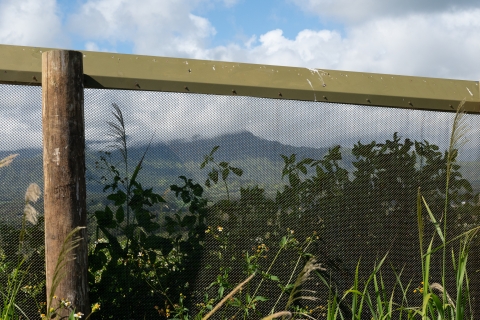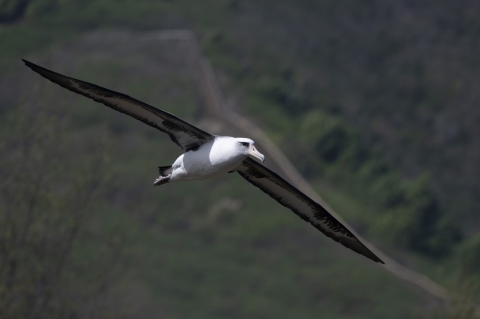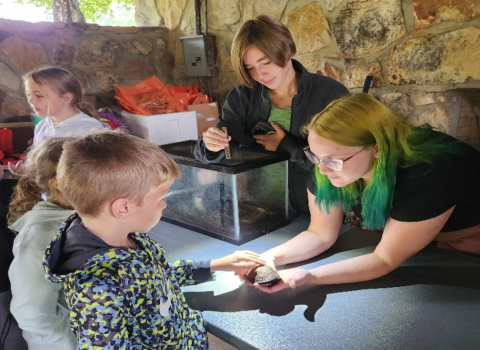Kīlauea Point NWR Predator Exclusion Fence
Construction of the Kīlauea Point National Wildlife Refuge (KPNWR) predator exclusion fence completed last fall and we are now in our final stage of the project—eradication of non-native predators.
Once all predators are removed from the enclosure the 11, 200-foot fence will help protect 168 acres of wildlife habitat for tens of thousands of nesting seabirds of at least seven species including threatened ʻaʻo (Newellʻs shearwater), ʻuaʻu (endangered Hawaiian petrel), and mōlī (Laysan albatross). It is also important habitat for the threatened nēnē (Hawaiian goose), endangered ʻopeʻapeʻa (Hawaiian hoary bat), and many rare, protected plant species.
What is a predator exclusion fence?
A predator exclusion fence is a special type of fence that is designed to keep out mammalian predators including cats, dogs, pigs, mongooses, rats, and mice. The fence is tall enough to prevent predators from jumping over, has a curved hood to prevent them from climbing over, mesh small enough to prevent even a 2-day old mouse from squeezing through, and a skirt that extends underground to prevent animals from digging under it.
Why and where are they used?
Predator exclusion fences are used to create protected areas for vulnerable native species that are free of predator species and are primarily used on islands where destructive mammalian predators have been introduced. They were developed in New Zealand and have been used in Hawaiʻi since 2011 and more recently, in Australia and Mexico.
Unfortunately, even with long term predator removal programs in place, invasive predators, such as cats and pigs, have intermittently decimated nesting seabirds on the refuge, including close to 70 albatross nests that were lost this season alone. A predator exclusion fence prevents these animals from entering the refuge and thus provides protection for the tens of thousands of nesting birds. A similar fence on Oʻahu saw the number of Shearwater chicks quadruple in the first several years after the fence was completed, and it is hoped that similar successes will be realized at KPNWR.
Why is Kīlauea Point NWR an ideal location for this type of fence?
Nihokū and Mokolea Point are ideal nesting locations for seabirds. The hills and plateaus within this portion of the refuge rest on the northern coastline where seabirds can easily land and take off. The area is free of light-pollution which can be especially dangerous for fledging petrels and shearwaters who navigate by the moon and stars. Artificial lights can disorient the birds and cause them to return to land instead of navigating out to sea. Finally, there are no above-ground powerlines or other infrastructure within the site that present a high risk for bird collisions.
Biologists estimate the refuge could support hundreds of thousands of birds. The protected area is considered high island refugia meaning that because it is well above sea level and provides habitat that is safe from sea level rise that is already threatening many of the other lower lying remote Pacific Islands.
How will new seabird colonies become established in the protected area?
The Kīlauea Point NWR is already home to some of the largest breeding colonies of seabirds within the main Hawaiian Islands. In order to encourage establishment of new breeding colonies of birds, biologists use a wide array of tactics to attract prospecting birds including installing artificial nest boxes, using decoy birds, playing the calls of targeted species over a loudspeaker, and translocation of individuals or eggs.
In 2016, the U.S. Fish and Wildlife Service worked with a number of partners, including Pacific Rim Conservation, Hawaii Department of Land and Natural Resources, National Tropical Botanical Garden, National Fish and Wildlife Foundation, and Kauaʻi Endangered Seabird Recovery Project to translocate ‘ua‘u and ‘a‘o chicks from montane nesting areas within the Hono O Nā Pali Natural Area Reserve and the National Tropical Botanical Garden at Upper Limahuli to the artificial burrows within a small 7-acre predator proof fence at Nihokū (see www.nihoku.org for more information). ‘Ua‘u and ‘a‘o chicks imprint on their birth colony location the first time they emerge from their burrows and see the night sky. They later return to breed at the same colony as adults several years later. Four ʻuaʻu pairs from this translocation project have already returned and nested this season and two ʻuaʻu chicks have already successfully hatched. Also spotted was a translocated male ʻaʻo sharing a burrow with an unbanded wild bird that appears to be the first socially attracted ʻaʻo on Nihokū since the project began.
We are hoping to see more returning and prospecting birds every year as the colony grows and the native wildlife at the refuge is more protected from invasive mammal predators with the completion of the predator exclusion fence. With an elevation well above projected sea level rise, the refuge can also serve as an important restoration site for seabirds threated by rising sea level in the Northwestern Hawaiian Islands.







